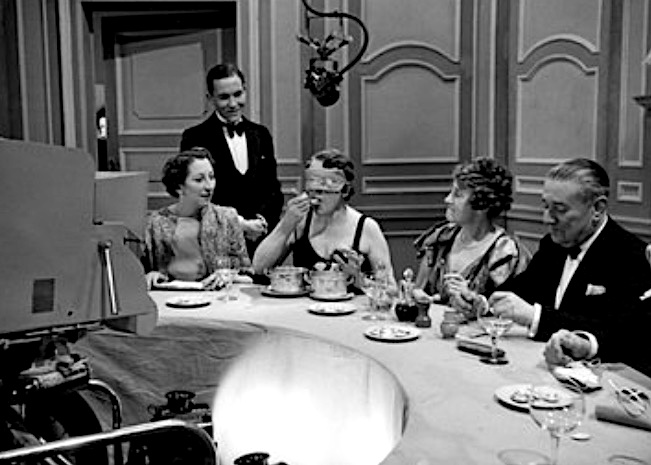OTD in early British television: 21 May 1939

John Wyver writes: The day before the transmission variously called Bee for Boulestin or Blind Man’s Buffet on the evening of Sunday 21 May 1939, the Daily Telegraph ran an excited preview. ‘Mrs Mary Adams, the BBC producer,’ ‘Our radio correspondent’ promised, ‘has invited a number of guests who will consent to be blindfolded and led to a buffet laden with food and drink.’
A team of three men was to compete against three women, who
may be asked to distinguish between Camembert, Gruyere and Gorgonzola cheese, red and white wines, the various constituents of hors d’oeuvres, tinned and fresh food and different kinds of poultry.
One of the participants was to be philanthropist Dowager Lady Swaythling ‘who recently confessed she preferred a kipper to caviare.’
Television chef Marcel Boulestin was master of ceremonies and Mary Adams’ deputy A. Miller Jones did the business with the blindfolds (and also apparently had to buy cigarettes for the production). Along with the kipper-loving Dowager, the ladies were food writer Elizabeth Craig and actor Martita Hunt who would have her moment of glory as Miss Havisham in David Lean’s great adaptation of Great Expectations (1946).
The gents were illustrator Edmund Dulac, journalist and pomologist P. Morton Shand (and incidentally paternal grandfather of Queen Camilla) and soldier poet and novelist Norman Davey, and the PasB form records also that ‘one of M. Boulestin’s waiters, bronson, served.’
By way of a review, the Daily Telegraph hailed the programme as ‘one of the most entertaining events yet televised.’
The result was extraordinary. The women easily beat the men on food by 7 1/2 marks to 4, but on drinks the men gained an advantage by just half a mark.
The doughty Dowager was on hand with a further quip:
‘It was one of the most cheery parties I have ever attended. There was more spontaneous humour than one would meet in a month of Sundays. One man could not tell champagne from cider. I had a difficult one – Grade A milk and goat’s milk – but I gained a point on it.’
The following day, the paper also reported that the broadcast
was one of the most popular items ever televised to judge by the enthusiastic comments which reached Alexandra Palace yesterday.
Bee for Boulestin was one of an occasional series of what were essentially middle-class parlour games, initially based on the familiar ‘spelling’ model, that Alexandra Palace broadcast during its final year of pre-war activities. There were ones about art, geography, the budget and even a contest to identify objects by touch alone.
What’s apparent both from the list of panellists and the evening dress apparent in the photograph above (Martita hunt on the left, A. Miller Jones standing, then Elizabeth Craig blindfolded, Lady Swaythling and Marcel Boulestin) is how extraordinarily posh it all was, reflecting the assumed aspirations of the metropolitan middle-class audience.
Following straight on in the Sunday evening schedule was one of the rare film documentaries acquired and screened by the pre-war service, Pare Lorentz’s The Plow That Broke the Plains (1936) about the causes of the Dust Bowl tragedy in the United States and the efforts of the Roosevelt administration to combat this. Coincidence or sly counter-programming? Whatever, the film can be viewed here courtesy of PublicResearchOrg (and do also read Robert Snyder’s introduction here [.pdf]):
[OTD post no. 155]
Leave a Reply